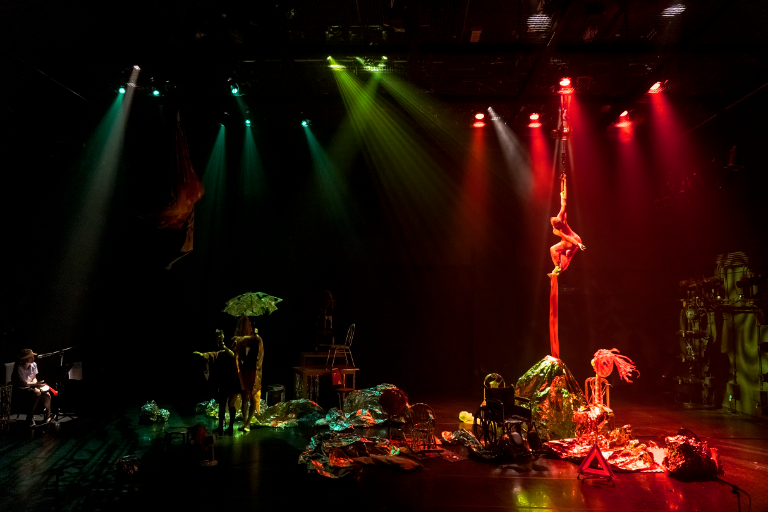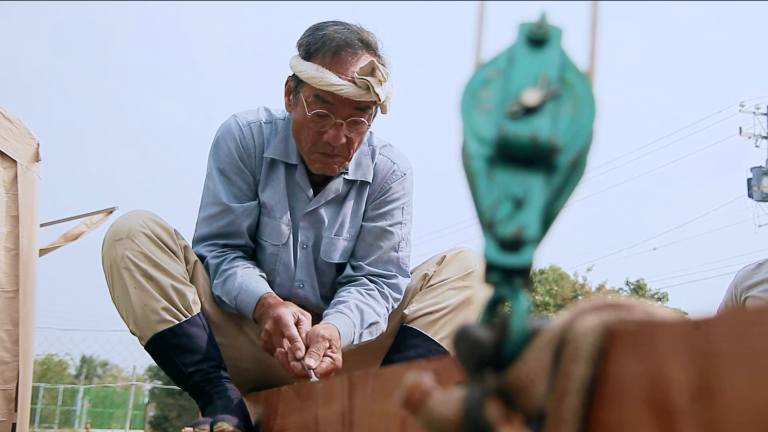The year 2022 was an explosive year for Lin Ting-Syu and the group, Autumn Cedar Sóo-Tsāi.
In the span of a year, they had presented three productions in southern and northern Taiwan, with The Golden Crow that Does Not Exist showcased in early April at the Kaohsiung Spring Arts Festival, which integrated the culture and rituals of Taiwan's Taoist Zengyi School with contemporary dance and sound art, presenting a spiritual world that's rich with Taoist cultural elements. Then by the end of the same month, Voyage through Mountains and Seas was presented as a part of the 14th Young Stars New Vision, which saw the spiritual world of folk beliefs explored by Lin in his past works transformed by the mountains and seas of Lanyu (Orchid Island), with an energy manifested. In November, Picking the Corpus was performed at the 2022 Taiwan Dance Platform organized by the National Kaohsiung Center for the Arts, which departed from the perspectives of the group’s long-term collaborators, dancers Chen Hsin-Yu and Wen Yun-Chu, to explore the life history of individuals that are intertwined with the development of the island.
The explosive year was also fruitful. Two of these three productions, The Golden Crow that Does Not Exist and Voyage through Mountains and Seas, were nominated for the 21st Taishin Arts Award, and The Golden Crow that Does Not Exist advanced into the intensely competitive final round. Luck might have played a role in the heightened exposure and fruitful outcome, but it was certainly not a fluke. As shared by Lin, since renaming the Lin Ting-Syu Studio to Autumn Cedar Sóo-Tsāi in 2022, he and the group members became quite busy pitching project proposals and undertaking projects. The tightly-scheduled performances and accolades received then prompted Lin to ponder on art, everyday living, and life.
During a visit to the Big Event Theater, a rehearsal space where the group is based in Kaohsiung, Lin was interviewed at the Dual mu Café on the theater's second floor. This article shares the transition Lin has gradually made with his creative practice and how he balances running a performance group with his personal life.
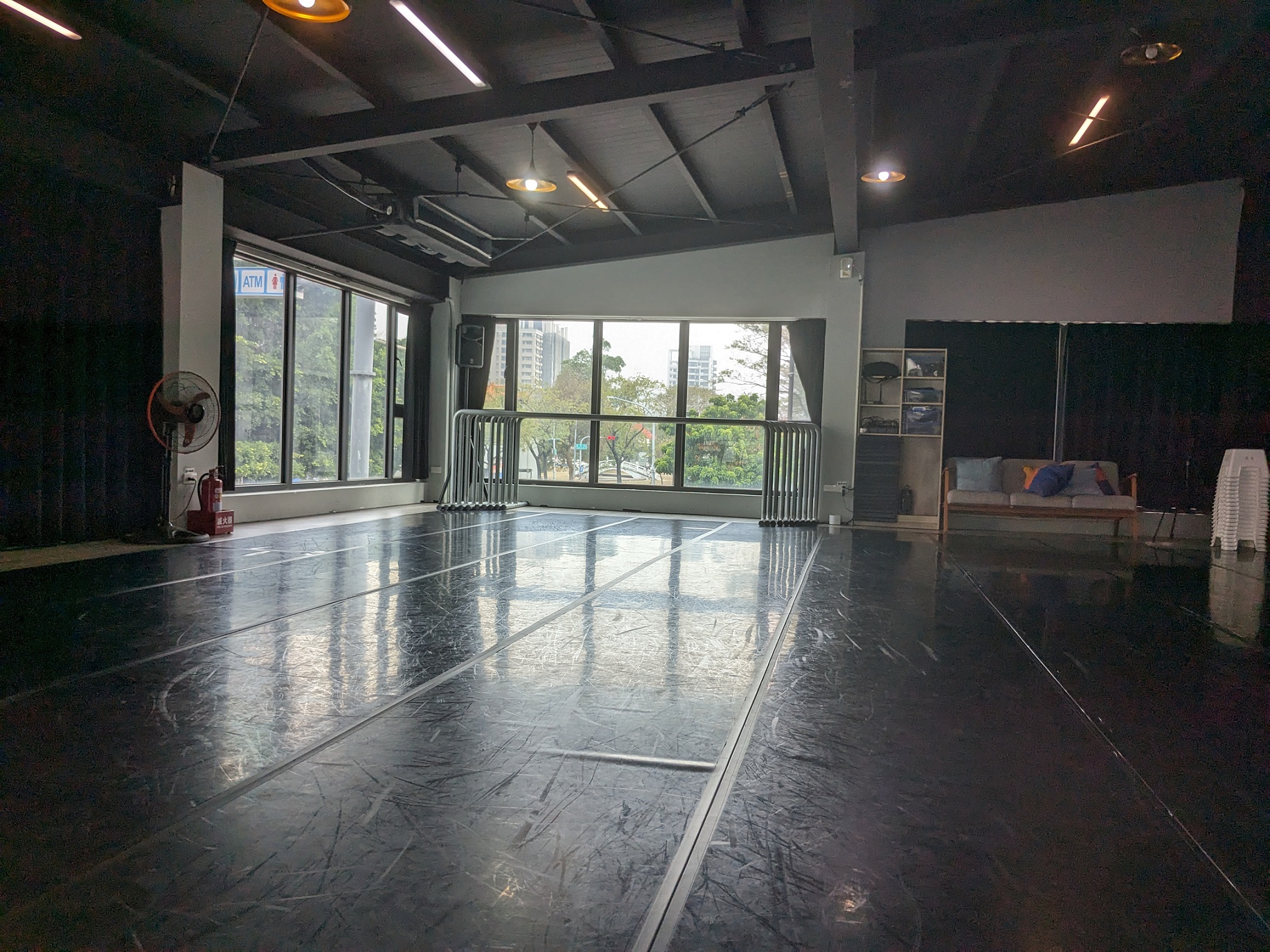
Big Event Theater in Kaohsiung (Photo: Fan Xiang -Jan)
Leaving Yourself Behind but Growing Closer to Your Creative Journey
Voyage through Mountains and Seas marked a transition in Lin's focus on folk beliefs, but this observation is perhaps not entirely accurate. Thematically, Voyage through Mountains and Seas was the first work by Lin created out of the transition made from his three-year examination of folk beliefs between 2017 and 2019. The highly acclaimed Deluge (shortlisted for the 18th Taishin Arts Award), The Invincible Swiftness of the Golden Crow in 2019, and the also shortlisted The Golden Crow that Does Not Exist in 2022 were the productive outcomes generated from the energy accumulated from those three years of survey and research. However, in reviewing Lin's earlier works, we can see that he has always focused on humanity's state of existence and the spiritual world, and a visible body is where light can shine on the unseen. Voyage through Mountains and Seas can be considered a return to the roots of compassion.
An artist's creative theme is the external manifestation of their expression, which is connected to the audience's initial perception of the artist's work, their knowledge of the artist, and how the artist is positioned. However, for some artists (Lin Ting-Syu included), the actual core of their creative practice lies in the propelling force that generates creative kinetic energy, and this force is about people, about life. As mentioned by Lin, after a particular curtain call with the dancers, he suddenly felt numbed towards applauses. This sense of impassiveness was not a loss of enthusiasm for theater, dance, or performance; rather, he realized that what was more important to him was the daily routine of rehearsing with the dancers and working with the team and the design group. For Lin, “it is the warmth of human relationships that drives the direction of my creative work.” Although this realization occurred at a particular moment, traces of it can be spotted throughout his creative journey.
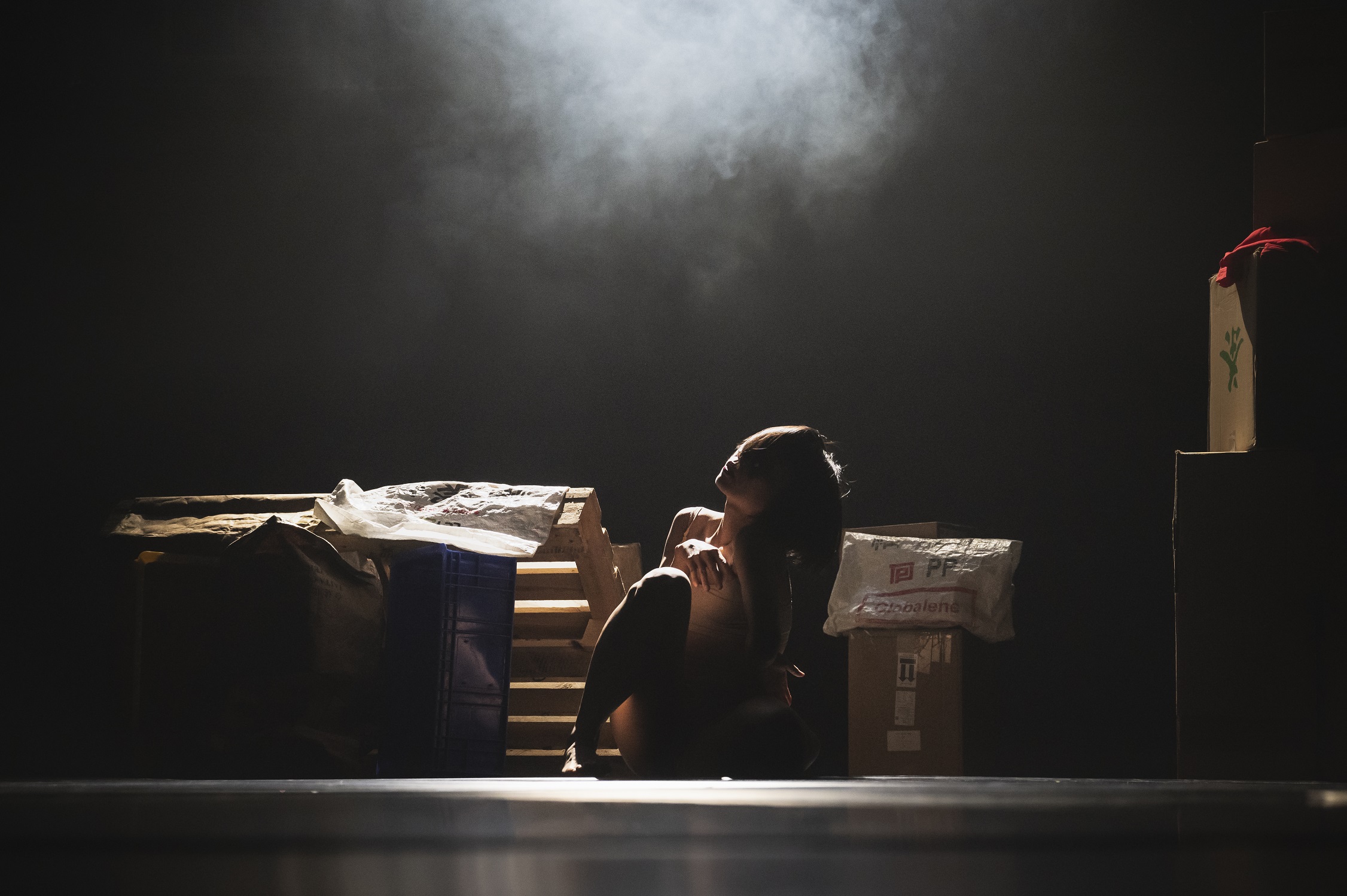
Autumn Cedar Sóo-Tsāi, Voyage through Mountains and Seas (Photo: Wu Po-Yuan)
One of the most touching moments in Voyage through Mountains and Seas was when the dancer Chen Hsin-Yu, surrounded by several cardboard boxes, reenacted a scene from when her mother passed away; wholeheartedly dedicated and exerting her whole might, it felt like the dancer's consciousness and soul were pouring out of her body. While working on this segment in the performance, Lin's creative direction gradually shifted. In the past, the focus of Lin's work was solely based on the spiritual world that he sought to explore, with him shaping and visualizing a worldview through a first-person perspective. Then, during rehearsals, it was through Lin's aesthetic perspective that bodies were adjusted, movements sculpted, and scenes illustrated. However, Lin's past approach hit a wall in this solo dance number on the story of Chen's mother. In the words of Lin, “[Chen Hsin-Yu's] section was a spiritual world that I couldn't interfere in; it's unshakable. I had to take several steps back to work with her on this solo dance number.” He then realized that he should listen to the dancers more and give general advice during rehearsals rather than provide specific instructions that are oriented around his own aesthetic preferences.
Moreover, Lin's previous customary way of working was to survey and study temples alone. In recent years, with more subsidies made available and the prize money received for his Tashin Arts Award nominations, he has become more capable of conducting fieldwork with a team. Voyage through Mountains and Seas was created by spending time with his team members on Orchid Island. Through being on the island, the dancers benefited both physically and mentally by being out in nature, which Lin thought was quite moving and invaluable, and the experience was also quite personal. The movement development for the number with the three dancers, Hsieh Chih-Ying, Wen Yun-Chu, and Chao Yi-Ying, saw them moving their bodies like leaping waves and also incorporated a great deal of the dancers' personal physical and mental experiences from when they were out by the mountains and the seas. Lin's shift in his creative approach gradually started with these two numbers in Voyage through Mountains and Seas. For him, it was vital for a new creative practice to emerge.
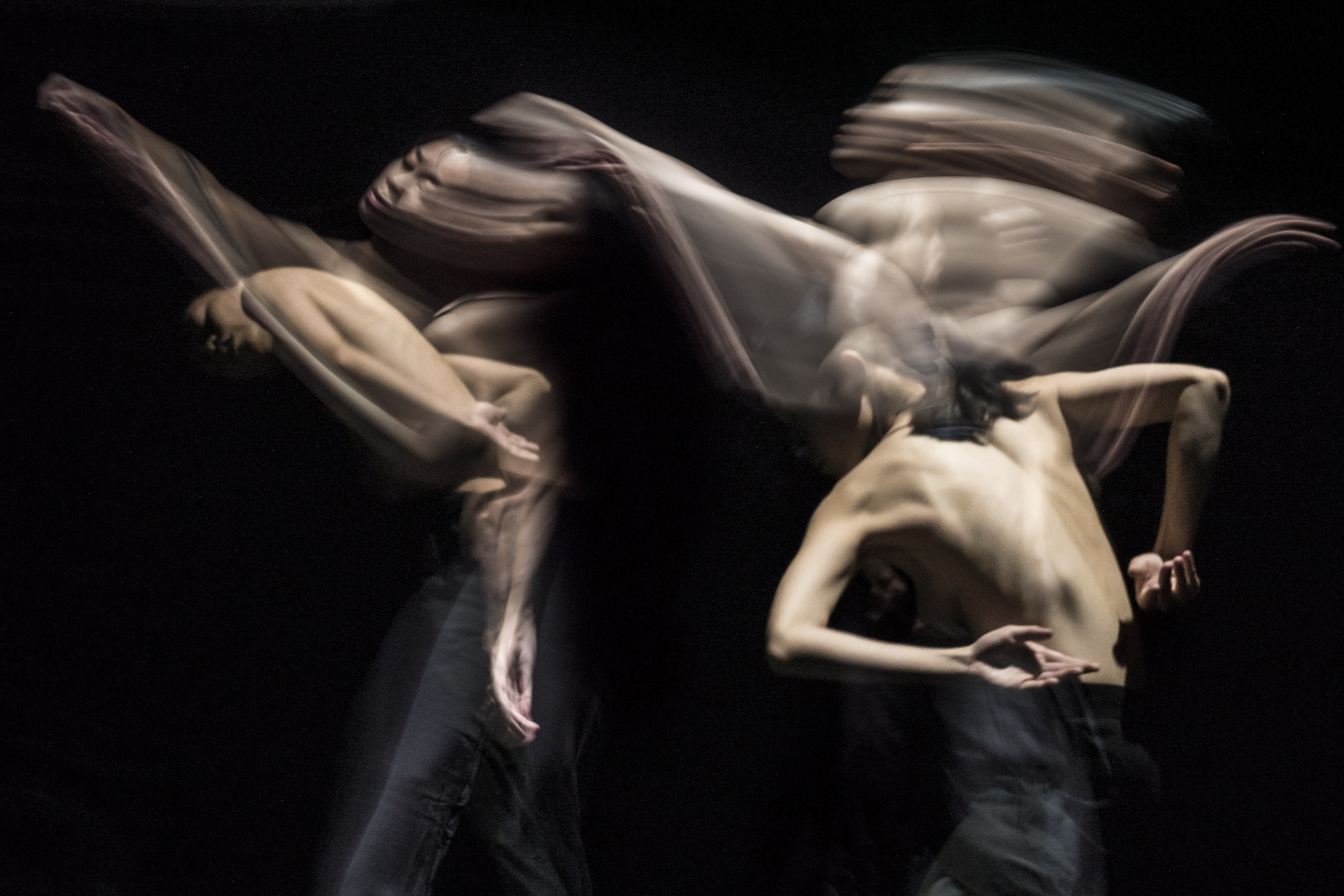
Autumn Cedar Sóo-Tsāi, Voyage through Mountains and Seas (Photo: Chen Chang-Chih)
From the Spiritual World of Taoist Culture to the “Human” World
With this shift in creative practice, Lin also began to show a shift in the creative subject matters that he works with. Picking the Corpus, created after Voyage through Mountains and Seas, is called “採身” in Chinese, which means to gather one's identity or body. As the name suggests, Lin joined the project's dancers in revisiting their childhood homes, where they used physical expressions to gather their past identities. The identity of Lin, the choreographer, wasn't what was gathered. The focus was on the identities of the two dancers, Chen Hsin-Yu and Wen Yun-Chu, whom Lin has collaborated with extensively. Born in Erlin Township of Changhua County, Chen's family owned a suitcase factory during a time when Taiwan saw an economic boom. With the decline of Taiwan's processing industry, their factory in Changhua eventually had to shut down. Following the creative development of Picking the Corpus, Chen recalled the factory of her childhood and the memories of the countryside that are a part of her. Wen Yun-Chu, a girl from a noble family of the indigenous Paiwan Valjulu Tribe who moved to the city in northern Taiwan in her youth with her father, has long felt that her roots are foreign and distant to her, but in the course of the creative development of Picking the Corpus, she was able to return to her unfamiliar tribal village in southern Taiwan's Pingtung to try to connect with her past and future.
Autumn Cedar Sóo-Tsāi, Picking the Corpus (Photo: Lin Ting-Syu)
Although the two dancers have very different life journeys, they are both part of this island's destiny. From Voyage through Mountains and Seas to Picking the Corpus, we can see Lin's gradual shift from the spiritual world of Taoist culture toward more visual, tangible bodies and also closer to the invisible, intangible state of existence of one's heart. On the other hand, we also see the artist's move from a personal and religious family history to the intertwined destinies of the people on the island of Taiwan. This shift in approach and theme appeared “to be leaving the self behind, but in fact, it is about growing closer to yourself,” said Lin, pensively. Perhaps, this sense of self is not a closed and inward exploration of one's own life and the spiritual world, but rather, it is a self that is connected to the outside, where the internal and the external are interconnected and mutually refractive and reflective.
New Work in Progress: ‘Guardians on a Glazed Tile Roof’
Maybe it was a period of calm that followed the explosively intense and busy 2022, so the year 2023 appeared comparatively quieter for Autumn Cedar Sóo-Tsāi in terms of showcasing their work; nevertheless, Lin and the team have remained active and kept working on their creative endeavors.
Guardians on a Glazed Tile Roof is the work they are currently developing. The work's Chinese title, “大吻琉璃,” refers to zhengwen (正吻) or dawen (大吻), which are mythical beast-shaped ornaments placed on the roofs of temples and appear to be biting onto the two ends of the roof ridge, and “琉璃” means colored glaze, referring to the glazed tiles seen on temples. This particular mythical beast is related to the element of water and is said to be one of the nine sons of the Dragon. It has a dragon head and the body of a fish and is a fierce biter and swallower. It's seen with water oozing from its mouth, which moistens its vocal cords. Since most of the ancient buildings were made of wood, placing this mythical beast on the buildings was believed to have the effect of protecting them from fire and evil spirits. Moreover, the roofs of temples are typically covered with glazed tiles. The title of this dance piece suggests Lin's focus is not only on the Taoist culture and the spiritual world but also extends to the sentient beings that are closely related to this culture, which in Guardians on a Glazed Tile Roof are the workers responsible for laying the glazed tiles.
Autumn Cedar Sóo-Tsāi, Guardians on a Glazed Tile Roof (Photo: Lin Ting-Syu)
In an image shared by Lin to explain this creative work, a worker is seen standing on the roof of a temple, with two pails in his hands. Lin then used a pen to point at the actual temple building and commented, “My previous focus would have been on this,” and he then shifted his pen to the glazed tile worker and said, “My focus is now here.” This reminded me of a past interview in which Lin vividly talked about the different postures of the gods of literature and martial arts seen in temples.[1] Now, he has shifted his focus to the workers who are encumbered by the realities of life, who may be facing problems with their children and have other family issues, and who have to deal with work-related injuries and possibly even fatal accidents.
Lin has always had close ties to temples. His uncle was a member of a tiling crew, and because of him, Lin was able to follow the crew to visit various temples. Unfortunately, his uncle passed away in July last year. Following a project undertaken by the crew, Lin visited the Fudingjin Baoan Temple in Kaohsiung in June of the same year, and in July, together with the sound designer, Hsu Yen-Ting, they visited the Dazhong Temple in Sicao, Tainan, where they made sound recordings; a trip to the Mazu Temple in Yizhu, Chiayi then followed. Just a month before our interview, Lin had followed the crew to Erlin Township in Changhua to carry out a construction project. In Lin's eyes, the workers live a nomadic life, bouncing from place to place, moving from one tiling project to the next. The cost of building a temple can range from tens of millions of New Taiwan Dollars to hundreds of millions. If the project owner is generous, the workers would be able to stay in hotels or guesthouses, but if the owner is financially constrained, or when the project's location is remote, and accommodation is not available, the workers would have to set up tents and spend the night inside the temple.
Involving Dance in Labor Situations
Lin's original intention for using dance to get involved in the work and everyday life of the tiling crew was “to bring dance into temples and to document with art to feel the blood and sweat of these grassroots workers and to use bodies to replicate the value of their labor.” On the one hand, through Guardians on a Glazed Tile Roof, Lin's intention is to share the stories of the crew with the public, but on the other hand, what has been driving Lin in this direction is a connection that cannot yet be put into words. He senses that the tiling workers and modern dancers seem to share a certain similarity, and it's not about the physical conditions they endure, such as the environments that they work in, but has to do with an intangible dimension that is both physical and psychological. “They are both contributing a great deal of physical exertion; tiling workers are working on the rooftop of temples, and through performing, contemporary dancers are seeking to reach the peak of their career,” explained Lin. “But I also know that there's a great disparity between them, and perhaps it is this gap that drives me to want to further explore it using art,” he added.
While following the construction crew on their temple projects, the “realness” of those workers was particularly memorable to Lin. “It is a realness that's open and exposed. It is raw and unpackaged.” For Lin, who has been paying attention to the physical and mental depletion of laborers since Voyage through Mountains and Seas, there is an inexplicable closeness that he holds deep inside. The struggles of survival and the realities of life, which the workers have to endure, are topics that come up repeatedly in Lin's conversations with his friends from the construction crew. As shared by Lin, “Someone on the tiling crew may have pulled his back in the morning, but you would still see him at the construction site in the afternoon. Or someone who had almost fallen on the job the other day and luckily escaped being injured or killed because he was able to grab onto the scaffolding would still show up on the rooftop of the temple the next day. They have to keep working to make ends meet for their families.” To carry on with life, they have to endure injuries and also put up with inhumane conditions at work. It is perhaps far-fetched to compare the working conditions of contemporary dancers in air-conditioned rooms with smooth mat floors with the highly exhaustive and dangerous conditions faced by the tiling workers. However, on the other hand, what's that sense of “peak” that contemporary dancers strive for when they also endure similar physically and mentally straining conditions when they work? What is the driving force behind them?
Supported by the National Theater and Concert Hall, Guardians on a Glazed Tile Roof completed its initial research and development and presented its preliminary progress internally in September 2023. It then received a commission for the 2024 NTCH IDEAS Lab, with performances scheduled for June 2024. However, Lin's imagination and vision for Guardians on a Glazed Tile Roof are not confined to just theater and dance. He meekly revealed that in addition to the June theater performances, plans are being made to present Guardians on a Glazed Tile Roof in a way that differs from the theater version.
Autumn Cedar Sóo-Tsāi, Guardians on a Glazed Tile Roof (Photo: Lin Ting-Syu)
Journey from Independent Artist to Running a Group
As aforementioned, Lin Ting-Syu Studio was renamed Autumn Cedar Sóo-Tsāi in early 2022, and Lin has gone from an independent artist to an art director leading his group to work and perform in various places. Anyone in the performing arts circle would know that becoming a group leader or art director does not make the work more “artistic” nor does it bump the work to a more “advanced” level; on the contrary, because of the pressure from running a group, the workload tends to grow heavier, and the group would become busier, but this doesn't mean that their income would also go up. The survival of a group tends to depend heavily on grants and performances held at venues; subsidies and grants are crucial for supporting the group members, and they need to put on a lot of performances to gain exposure so that more opportunities can follow. Unfortunately, an abundance of performance opportunities does not mean that the group can become completely self-sufficient, and more often than not, it can lead to a great deal of physical and mental exhaustion on its members. Like an overworked machine that can't afford to stop, this is a conundrum that those in the contemporary performing arts field are still struggling with.
From 2020 to 2023, Autumn Cedar Sóo-Tsāi pitched and took on many projects. Many would probably say that it's good to be busy, but it also caused Lin great physical and mental exhaustion. What made him even more mentally drained was that despite the excessive amount of work done, he was still not in a position to pay the dancers reasonably. Lin shared with a sigh, “Although our group has received many opportunities to perform on many platforms and received a lot of subsidies and grants, the dancers are still underpaid, which is something that really saddens me.” He further asserted, “Even though I've been paying the dancers a relatively high fee for every single performance and rehearsal from 2022 until now, on average, the pay received by the dancers in this industry is still too low.” In recent years, facing this phenomenon at large, Lin has also thought about referencing the management approaches of other groups and marketing and brand-building tactics. However, through further reflection, he realized that this would go against his original intention of making art, and he has also seen many others in the same field, including his contemporaries and those before him, suffering from physical harm and mental exhaustion from overworking, even to the point of endangering their lives. He repeatedly asked himself if that was the life he wanted and reflected on his relationship with his art.
Lin has been diligently working on creating dance for six years, a period that is neither too short nor too long. Lin reflectively sees that if he has been fortunate enough to be noticed by people and for others to look forward to seeing his work, it is not because of his group's good marketing or branding strategies, but rather because of his and his group members' dedication and the continual refinement they make toward their creative work. In light of this realization, he is now clear about what to do and that is “to make good art.” Under this premise, he has learned to pace how he works, which entails doing administrative work in the morning, and the afternoons are reserved for creative work and rehearsals. Weekends are for resting. He also doesn't force himself or the group to pitch or take on too many projects. There is a time for work, and there is also a time for rest. This is the principle he goes by right now to achieve a work-life balance. “In the past, I would say that creating dance was my life's mission, but I no longer say that now. However, for the remainder of my life, dance is something that I will always hold a fondness for,” Lin said with a smile.
“A fondness for” sounds quite lighthearted, but it reflects Lin's profound earnestness toward making art. In particular, from Voyage through Mountains and Seas, Picking the Corpus to Guardians on a Glazed Tile Roof, by shifting from a first-person to a second-person point of view, his creative subject has also shifted from the relatively intangible spiritual world to the living beings in this tangible sentient world. For Lin, art is now an important medium for him to reach out to others and try to empathize with them. To feel the warmth of others through art also enriches Lin, physically and mentally. This process of going back and forth, of seemingly moving away from oneself but actually getting closer to oneself, is an insight that Lin has now realized when it comes to art: “This sense of getting closer is actually not a pleasant feeling; it is really a bit cruel, but after observing and reflecting on it for a while, it’s also quite healing.”
Lin, who was in a specialized art class in high school, showed a piece of artwork about the gods in his graduation exhibition, and upon completing his master's degree, he created a number of dance pieces related to the Taoist culture and the spiritual world. Just as people have started to associate his creative work with religion, he then pivoted to the world of sentient beings, telling the stories of indigenous identity and childhood factory of his fellow dancers and also of the tiling crew. However, from the creative insights shared by him on the transformation of his creative approach and this drive that propels him to get closer to others, we can see that it is not that Lin no longer cares about spiritual faith and belief, but rather, it has been internalized into his mindset and actions. Now, Lin continues to “use his body to document the paths he has traveled, to explore the universal spirit of various humanistic and cultural issues, and to use contemporary art to demonstrate the social value of dance.”
Annotations
Fan, Shung-Jan.《乩身、亡者、法師,精與體的考察:林廷緒與他的舞蹈探索》 [Medium, the deceased, Taoist priest, an examination of spirit and body: Lin Ting-Syu and his exploration of dance] https://mag.ncafroc.org.tw/article_detail.html?id=297ef72270ca70160170e1407a750001
*Translator: Hui-Fen Anna Liao


